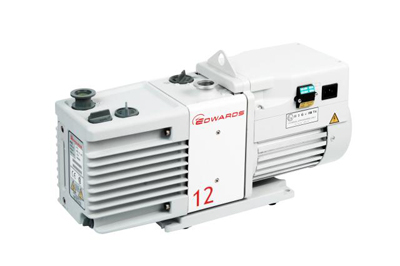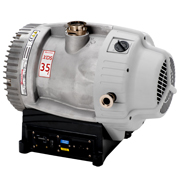As lab processes become automated, understanding the various pumping technologies is key to specifying the vacuum pump best suited to each application. Edwards highlights the various options.
In the multi-million pound drug development business there is an ever-increasing need for 100% reliability and minimum process downtime. Sample integrity is critical and scientists and manufacturers of laboratory equipment are continually looking for improvements. This includes reviewing the equipment used at every stage of the process. Key considerations include vacuum performance (speed, compression ratio, power), environmental impact, service interval and requirements (if any) for oil.
Vacuum pumps are a key piece of equipment used in a wide range of laboratory and chemistry applications, including gel dryers, rotary evaporation, vacuum ovens, centrifugal concentration and evaporation, vacuum filtration, distillation and extraction apparatus, freeze drying and mass spectrometry.
Vacuum pumps, such as oil-sealed rotary vane pumps (OSRVPs), have a proven track record and have been used for many decades, but as a ‘wet’ technology they have limitations as they require regular maintenance and oil changes. Recent developments have led to the emergence of dry pumps. Scroll pumps are an example of these and some of them, in particular those that employ a bellows mechanism, have no lubricants in the vacuum environment.
This separation offers two distinct advantages: first, the vacuum environment, and thus the process itself, is not contaminated by the grease lubricant in the pump’s bearings; and second, the bearings are not contaminated by the process, thus increasing the service life of the pump. As no oil is used in a scroll pump, there is no need to have to dispose of the oil safely after a service and of course no chance of an oil leak.
These pumps are described as primary pumps and generally have pumping speeds in the range of a few m3/h up to 50m3/h. They operate in a pressure range from approximately 0.01 to 100 mbar and exhaust to atmosphere.
Turbomolecular pumps are secondary pumps used in combination with primary pumps. In this case, the primary pump acts as a backing or foreline pump. Turbomolecular pumps operate in the molecular flow regime and achieve a much better ultimate vacuum, usually 10-8 to 10-10 mbar. However, in typical laboratory applications their operating pressure can range from 10-2 to 10-8 mbar and pumping speeds can be from 50 to 500 l/s.
When choosing which vacuum pump is best suited to an application there are a number of factors to consider:
Capacity: This refers to the nominal pumping speed of the pumps or, more important, the throughput for process-target gases at a nominal process pressure. However, as discussed above, some applications, such as mass spectrometry, often require higher levels of vacuum, in which case a primary pump is combined with a turbomolecular vacuum pump. In some configurations, several interlinked chambers need to be pumped at the same time. This can be achieved by the use of individual turbomolecular pumps or by the use of split-flow pumps whereby one pump has two (or more) inlets and can pump several chambers (with different flows and pressures) simultaneously.
Reliability, maintenance and end-user serviceability: There is a greater demand for pumps to work for long periods of time with minimal intervention. Downtime can be extremely costly and so the use of reliable, high quality equipment is critical. This demands simplification of the service elements and a maximisation of the interval between services. A pump that enables an end-user to perform routine services simply and quickly allows for maximum uptime and reduces service costs.
Environment and cleanliness: Laboratory cleanliness is of utmost importance as process contamination can result in costly wastage of samples. Pumps that are clean, and have no oil, have been developed to address these concerns.
pump types
There are various types of pumps that offer high performance operation. Primary pumps, such as rotary and scroll pumps, give ultimate pressure to 10-2 mbar and can be used singularly in some applications. They can also be used as backing (foreline) pumps in combination with secondary pumps to create higher vacuum for applications such as mass spectroscopy.

Edwards rotary vane
Wet pumps, such as rotary vane pumps are oil sealed, which means they use oil to lubricate, cool and seal the pump. In any wet pump oil liquid and vapour coexist in the vacuum space.
OSRVPs have many benefits as they offer good ultimate vacuum, fast pumping speeds and are reasonably quiet in operation. They are also relatively inexpensive. However, as they contain oil, they require frequent maintenance (as the oil degrades over time) and it is extremely important that this is carried out thoroughly to get the best continuous performance from the equipment. Oil changes can be frequent and should be carried out according to the manufacturers’ instructions.
With OSRVPs there is not just the possibility of oil contaminating the process material but also the process material contaminating the oil which, depending on the nature of that material, may make it more difficult to dispose of. These pumps also need to be configured (for example using gas ballast, mist filters and oil return kits) to best fit their pumping purpose.
Dry pumps, in comparison, have no sealing fluid and oil is therefore eliminated from the vacuum pumping volume, resulting in a number of significant benefits. As there are no lubricants under vacuum, this obviates the need for regular oil changes, thereby reducing maintenance.
The maintenance requirement for a dry scroll pump is minimal: the tip seal requires changing every 12 to 24 months depending upon the application. This operation can take between 20 minutes and two hours depending on the pump design and manufacturer. A major service interval is four to five years and usually the pump’s bearings are changed at this time. Environmental impact is also minimised and users do not have the cost of disposing of used oil.

Edwards dry scroll pump XDS35i
Edwards’ innovative XDS is a dry scroll pump that has been designed in such a way that the bearings are isolated from the vacuum by a bellows so no bearings, bearing purges, grease or oil are in contact with the vacuum environment. The bearing shield (bellows) also protects the bearings from any process materials.
Adjustable gas ballast allows vapour to be handled and opens up the range of applications to many that were previously unsuited to scroll pumps. The XDS pump is designed for pumping condensable vapours and has proven capability in laboratory applications involving aggressive chemicals. It offers reliable operation despite the presence of solvents and is ideal for a wide range of laboratory wet chemistry applications.
recent additions
Within the XDS portfolio, the XDS35i offers a high speed of up to 35m3/hr, the XDS10 gives pumping speeds of up to 10m3/hr and the smaller XDS5 offers pumping speeds of up to 5m3/hr. These enable high throughput of solvents and fast evaporation in equipment such as centrifugal concentators and rotary evaporators. More recently an XDS46i pump and an XDS100B booster scroll pump have been added to the portfolio of products, the latter being used in combination with another scroll pump (XDS46i or XDS35i) to give pumping speeds of up to 100m3/hr. These rugged pumps are also quiet during operation with relatively low heat emission.
Ultra high vacuum pumping: In some applications (including electron microscopy and mass spectrometry) vacuum better than 10-7 mbar is required. Pumps commonly used to achieve high/ultra high vacuum include turbomolecular pumps, cryopumps, ion and sublimation pumps. Turbomolecular pumps are ideal for pumping to these pressures as their mechanism of operation means that they are generally more efficient in pumping a wide range of gases than the other UHV pumps.
Edwards’ most recent innovation in this arena is the nEXT turbomolecular pump, which provides high and ultra high vacuum performance and supplies the highest level of standard nitrogen pumping speed for its size – up to 400 l/s.
The nEXT pumps use innovative technology to offer high performance and reliability in a compact size, as well as easy user serviceability. The pumps also feature a ‘green’ mode, which helps users reduce their carbon footprint and save energy costs.
easy servicing
The key innovation is a novel compact metal spring damper that supports the lower mechanical bearing. This significantly reduces vibration from the rotating impellor from being transmitted to the pump body and, as a result, the pumps do not need high-speed balancing during manufacture or service. It also enables pumps to be serviced by the user in situ, which minimises downtime and significantly reduces operating costs. This is a major advantage offered by the nEXT pump because other turbomolecular pumps are typically returned to a service centre for servicing.
Edwards’ nEXT pumps are also available in a variant suitable for sensitive electron microscope applications. For these applications, L variant pumps have an even lower vibration signature and reduced levels of radiated magnetic field.
The pump is compact and its housing has been designed with an almost square external cross section, which allows the pumps to be placed in extremely close proximity. The nEXT range also features a dynamic stage in the pumping process with boost option.
The boost facility can be employed in two distinct ways and sometimes in combination. First, the mechanism is more tolerant to higher backing pressure, therefore a smaller capacity backing pump can be used. Second, the boost port can be used to pump on a chamber where previously a primary pump was employed directly. As a result, a 12m3h-1 pump may be used to replace the previously required 30m3h-1 backing pump, reducing overall vacuum system size, power and cost.
The power saving can be of the order of 400W for a typical backing pump. This power saving significantly reduces the cost of ownership of running an instrument directly, i.e. less power is used to drive it, and reduces the heat output of the backing pump, thus lowering the running costs of the air conditioning system cooling the environment local to the pump.
In conclusion, vacuum pumps are a vital piece of equipment in many scientific applications and there are several considerations when specifying systems to optimise processes and maintain sample integrity. It is important to consider fully the requirements of the application and seek expert advice before deciding which vacuum pumps are the best solutions. This is especially important when potentially flammable and otherwise dangerous materials are pumped.




